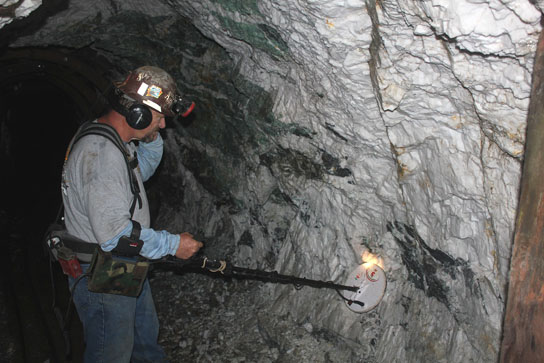Earlier this year I was given a very special opportunity to take my metal detector to one of the most famous underground gold mines in all of California, the original Sixteen to One Mine in the heart of the mother lode country at Allegheny. I was asked to give a little demonstration and talk about metal detecting technology, how it has changed and improved and to do some field testing of different types of detectors inside the mine.
I wasn't really there to collect gold for myself, but to help the miners and operators at the mine find the most amounts of gold possible because much of the gold in mind within the Sixteen to One mine is found with the help of metal detectors. Detecting for gold within this mine is a very high-stakes effort because there is little doubt that sitting unseen somewhere just beyond the walls of the mine workings are high-grade pockets filled with millions of dollars worth of gold. Of course no one knows exactly where these rich spots are, but metal detectors have proven to be an excellent tool in finding gold pockets here. I've known about this mine for years, and even visited the outside grounds once before, so I was truly excited about doing a little metal detector testing down inside one of the richest high-grade pocket mines ever discovered.

Unlike most hard rock districts in California, the chief production at Allegheny has come from small, but very rich pockets of gold ore that may contain anywhere from a few hundred to over 50,000 ounces of gold. A considerable amount of jewelry grade gold quartz is produced from these mines for use worldwide. The high-grade pockets usually occur within the veins and consist of a mixture of quartz vein material and free gold with minor amounts of sulfides.
The spectacular appearance of the gold in these high-grade pockets can fire up the imagination of any prospector. The most characteristic features of the ore deposits here include their extreme richness, erratic distribution and small size. For years the search for pockets was done by driving workings underground until pockets were struck in a somewhat blind manner. The introduction of metal detectors in the 1980s led to a revival in production which has continued to the present time.
In the Original Sixteen to One mine, most of the gold they find is leafy, forming thin sheets, in mossy accumulations, or in small wires. Because of the nature of the gold here, the underground miners use principally VLF metal detectors with high frequency so that they can pick up very small gold pieces. Minelab's pulse induction (MPS) machines are used to detect larger pieces of gold at a bit greater distances into the wall. The GP 3000 pulse induction detector they had at the mine was a few generations old and they wanted to take a look at the newest equipment and see how it performed in comparison to the VLF machines they use on a daily basis.
The most recent generations of Minelab detectors have become more sensitive to very small gold. They are still not the equal of high frequency VLF on the tiniest gold close to the coil, but the gap has been closed quite a bit in recent years. The advantage to the pulse induction machines is that they deal with mineralization better and can see a bit farther into the wall if the gold is large enough. Metal detectors are tools, and like any worker, these miners want to have the best tools available to them at their job.
Chris Ralph
Chris Ralph’s Prospecting Encyclopedia




















Comments
To make comments you must be logged in, please note comments will not display immediately due to moderation